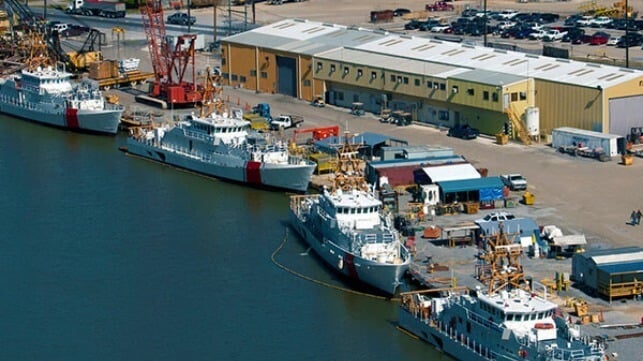Bollinger, Rauma, Seaspan and Aker Arctic Partner to Build USCG Icebreakers

Bollinger Shipyards has become the latest to take steps to position for the anticipated USCG Arctic Security Cutter shipbuilding program to fulfill Donald Trump’s mission to increase the U.S. presence in the Arctic. The shipbuilder, which has a long history with the U.S. Coast Guard, reports it is forming a new partnership with leaders for icebreaker construction, Rauma Shipyards of Finland, Seaspan Shipyards of Canada, and Aker Arctic Technology, one of the leading designers of icebreakers and ice going vessels.
According to the companies, the partnership leverages their unique skills and experience and the trilateral ICE Pact framework formed during the Biden presidency, partnering the U.S. with Canada and Finland to build a new generation of icebreakers. The partnership contends they have the best option for the program that would provide fast delivery, lowest risk, cost certainty, and would transition fully to American shipyards.
They are calling the Seaspan-Aker Multi-Purpose Icebreaker (MPI) design an “optimal design” to meet U.S. Coast Guard requirements. They report it exceeds all Arctic Security Cutter (ASC) requirements and supports all eleven statutory missions.
“With the ability to break four feet of ice, travel 12,000 nautical miles, and operate for over 60 days, the design is purpose-built to support the evolving mission needs of the U.S. Coast Guard in the harshest conditions. Additionally, its shared multi-mission design with the Canadian Coast Guard fleet will create the largest class of icebreaking capability in the world, optimizing interoperability and maintenance support,” they said in announcing the partnership.
The new partnership is positioning itself against other potential competitors for the lucrative contract. In June, Quebec-based Davie reported it is buying shipyard facilities in Texas as part of its commitment to the U.S. The company also acquired the Helsinki Shipyard, another major builder of icebreakers, and recently announced it is buying a smaller yard in Finland, which will be used to manufacture components. Davie also won a contract from the Canadian government to build another of the large icebreakers.
Seaspan and Aker highlight that they worked in partnership to develop the design for Canada. Canada has proceeded with the first orders, and the first ship is being built by Seaspan. In addition, Aker highlights that in the past 20 years, 59 icebreaking ships have been built at various shipyards based on its designs, with more than 20 vessels currently under construction or planning stages.
“We are fully prepared to begin construction immediately, leveraging a mature design and deep experience in building technically complex vessels for operation in severe winter conditions,” says Mika Nieminen, President and CEO of Rauma Shipyards. He notes that the yard has a fully operational production line and world-class facilities, while promising the partnership could deliver the first vessel within 36 months of the awarding of the contract.
“Speculative designs can derail programs, delay delivery, and devastate shipyards,” said Ben Bordelon, President and CEO of Bollinger Shipyards. “The Seaspan-Aker MPI design is the most mature, construction-ready design available.”
Bollinger at its shipyard in Louisiana is currently building the first Polar Security Cutter, the first heavy icebreaker to be built in the United States in 50 years. The project, which is based on a new design, however, has been badly delayed and experienced significant cost overruns in part as the design has been revised several times. Congress and others have been critical of the U.S. Coast Guard over this project and look to learn from it for future construction projects.
Congress and the Trump administration included a $25 billion investment for the U.S. Coast Guard in the recently passed budget, which has been called the largest single commitment of funding in the history of the USCG. The bill includes $1 billion for the acquisition of additional Fast Response Cutters, a long-term project executed by Bollinger.
Bollinger announced yesterday, July 28, that it has begun contract negotiations with the USCG for the construction of at least 10 additional Fast Response Cutters to be funded under the new legislation. The company notes it is currently working on the final order, number 67, which is scheduled for delivery in 2027. With construction underway, Bollinger said that its production line should have begun to wind down this year.
Bordelon, however, highlights the authorization for the company to go “at-risk.” He notes the yard spent millions to maintain its production momentum. It has begun procuring long-lead materials in anticipation of the contract for the construction of the 10 additional cutters.
The yard already has a broad orderbook for the U.S. Government. Bollinger highlights that it has also delivered over 180 cutters, including 60 Fast Response Cutters, to the USCG over the past 40 years. It is also contracted to build the Towing, Salvage and Rescue Ship (T-ATS), the Auxiliary Personnel Lighter (APL), the newest oceanographic survey ship (T-AGS 67), and the Mine Countermeasures Unmanned Surface Vessels (MCM USV) for the U.S. Navy. Bollinger is also building three Regional Class Research Vessels (RCRV) for the National Science Foundation through Oregon State University and supports the nuclear-powered ballistic missile submarine program by building various auxiliary vessels for General Dynamics-Electric Boat.
